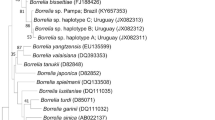Abstract
To investigate whether ticks of the genus Ixodes are infected by Borrelia burgdorferi complex, 490 unfed Ixodes ricinus ticks were collected by flagging in three different areas of Tunisia in 1998. DNAs extracted from 81 adults, 60 nymphs and 38 larvae were analysed after genic amplification of the noncoding spacer between the two copies of the rrl–rrf genes of B. burgdorferi sl. The prevalence of B. burgdorferi sl. in adults, nymphs and larvae was found to be 34, 33.3 and 2.6%, respectively. All DNAs (n = 61) but one were identified as belonging to different genotypes of B. lusitaniae by analysis of the restriction fragment length polymorphism of amplification products. In addition, 290 adults, 14 nymphs and 7 larvae were used to inoculate BSK-H medium to isolate spirochetes. Fifteen strains were isolated from adult ticks in the humid areas of Tunisia, whereas only one was obtained from larvae. Isolates were identified as B. lusitaniae (15/16) and B. garinii (1/16). These results provide new evidence for the existence of Lyme borreliosis in North Africa.
Similar content being viewed by others
References
Barbour AG, Burgdorfer W, Hayes SF, Péter O, Aeschlimann A. Isolation of a cultivable spirochete from Ixodes ricinus ticks of Switzerland. Curr Microbiol 1983; 8: 123-126.
Bouattour A, Dargouth M, Daoud A. Distribution and ecology of ticks (Acari: Ixodidae) infesting livestock in Tunisia: An overview of eight years field collections. Parasitol 1999; 41: 5-10.
Ouhabi H, Slassi I, El Aloui-Frais M, et al. Paralysie faciale et maladie de Lyme. Arch Inst Past Maroc 1994; 9: 51-55.
Rousselle C, Floret D, Cochat P, Reignier F, Wright C. Encéphalite aige à Borrelia burgdorferi (maladie de Lyme) chez un enfant algérien. Pédiat 1989; 44: 265-269.
Aoun K, Kechrid A, Lagha N, Zarrouk A, Bouzouaia N. La maladie de Lyme en Tunisie, résultat d'une étude clinico-sérologique (1992–1996). Cah Santé 1998; 8: 98-100.
Zhioua E, Bouattour A, Min Hu, et al. Infection of Ixodes ricinus (Acari: Ixodidae) by Borrelia burgdorferi sensu lato in North Africa. J Med Entomol 1999; 36: 216-218.
Postic D, Assous MV, Grimont PAD, Baranton G. Diversity of Borrelia burgdorferi sensu lato evidenced by restriction fragment length polymorphism of rrf (5S) rrl (23S) intergenic spacer amplicons. Int J Syst Bacteriol 1994; 44: 743-752.
Pollack RJ, Telford III SR, Spielman A. Standardization of medium for culturing Lyme disease spirochetes. J Clin Microbiol 1993; 31: 1251-1255.
Le Flèche A, Postic D, Girardet K, Péter O, Baranton G. Characterization of Borrelia lusitaniae sp. nov. by 16S ribosomal DNA sequence analysis. Int J Syst Bacteriol 1997; 47: 921-925.
Aesclimann A, Chamot E, Gigon F, et al. Borrelia in Switzerland. Zentralbl Bakteriol Mikrobiol Hyg 1986; (A)263: 450-458.
Hubalek Z, Halouzka J, Juricova Z. Investigation of haematophagous arthropods for borreliae-summarized data, 1988–1996. Folia Parasitol 1998; 45: 67-72.
Motiejunas L, Bunikis J, Barbour AG, Sadziene A. Lyme borreliosis in Lithuania. Scand J Infect Dis 1994; 26: 149-155.
Strle F, Cheng Y, Nelson JA, et al. Infection rate of Ixodes ricinus ticks with Borrelia afzelii, Borrelia garinii, and Borrelia burgdorferi sensu stricto in Slovenia. Eur J Clin Microbiol Infect Dis 1995; 14: 994-1001.
Hubalek Z, Halouzka J. Prevalence rates of Borrelia burgdorferi sensu lato in host-seeking Ixodes ricinus ticks in Europe. Parasitol Res 1998; 84: 167-172.
Rijpkema SGT, Molkenboer MJCH, Schouls LM, Jongejan F, Schellekens JFP. Simultaneous detection and genotyping of three genomic groups of Borrelia burgdorferi sensu lato in dutch Ixodes ricinus ticks by characterization of the amplified intergenic spacer region between 5S and 23S rRNA genes. J Clin Microbiol 1995; 33: 3091-3095.
Rijpkema SGT, Bruinink H. Detection of Borrelia burgdorferi sensu lato by PCR in questing Ixodes ricinus larvae from the Dutch North Sea island of Ameland. Exp Appl Acarol 1996; 20: 381-385.
Zhioua E, Postic D, Rodhain F, Perez-Eid C. Infection of Ixodes ricinus (Acari: Ixodidae) by Borrelia burgdorferi in Ile de France. J Med Entomol 1996; 33: 694-697.
Cinco M, Padovan D, Murgia R, et al. Prevalence of Borrelia burgdorferi infection in Ixodes ricinus in central Italy. Eur J Clin Microbiol Infect Dis 1998; 17: 134-135.
Lottmann H, Wilske B, Herrmann H. Characterization of Borrelia burgdorferi sensu lato strains isolated from Ixodes ricinus in Mecklenburg-Vorpommern, Germany. Med Microbiol Immunol 1996; 184: 181-184.
Postic D, Korenberg E, Gorelova N, et al. Borrelia burgdorferi sensu lato in Russia and neighboring countries: High incidence of mixed isolates. Res Microbiol 1997; 148: 691-702.
Sato Y, Miyamoto K, Iwaki A, et al. Prevalence of Lyme disease spirochetes in Ixodes persulcatus and wild rodents in Far Eastern Russia. Appl Environ Microbiol 1996; 62: 3887-3889.
Pichon B, Mousson L, Figureau C, Rodhain F, Perez-Eid C. Density of deer in relation to the prevalence of Borrelia burgdorferi sensu lato in Ixodes ricinus nymphs in Rambouillet forest, France. Exp Appl Acarol 1999; 23: 267-275.
Nuncio MS, Péter O, Alves MJ, Bacellar F, Filipe AR. Isolamento e caracterizaçao de Borrélias de Ixodes ricinus L. em Portugal. Rev Portuguesa Doenças Infecciosas 1993; 16: 175-179.
Author information
Authors and Affiliations
Rights and permissions
About this article
Cite this article
Younsi, H., Postic, D., Baranton, G. et al. High prevalence of Borrelia lusitaniae in Ixodes ricinus ticks in Tunisia. Eur J Epidemiol 17, 53–56 (2001). https://doi.org/10.1023/A:1010928731281
Issue Date:
DOI: https://doi.org/10.1023/A:1010928731281



